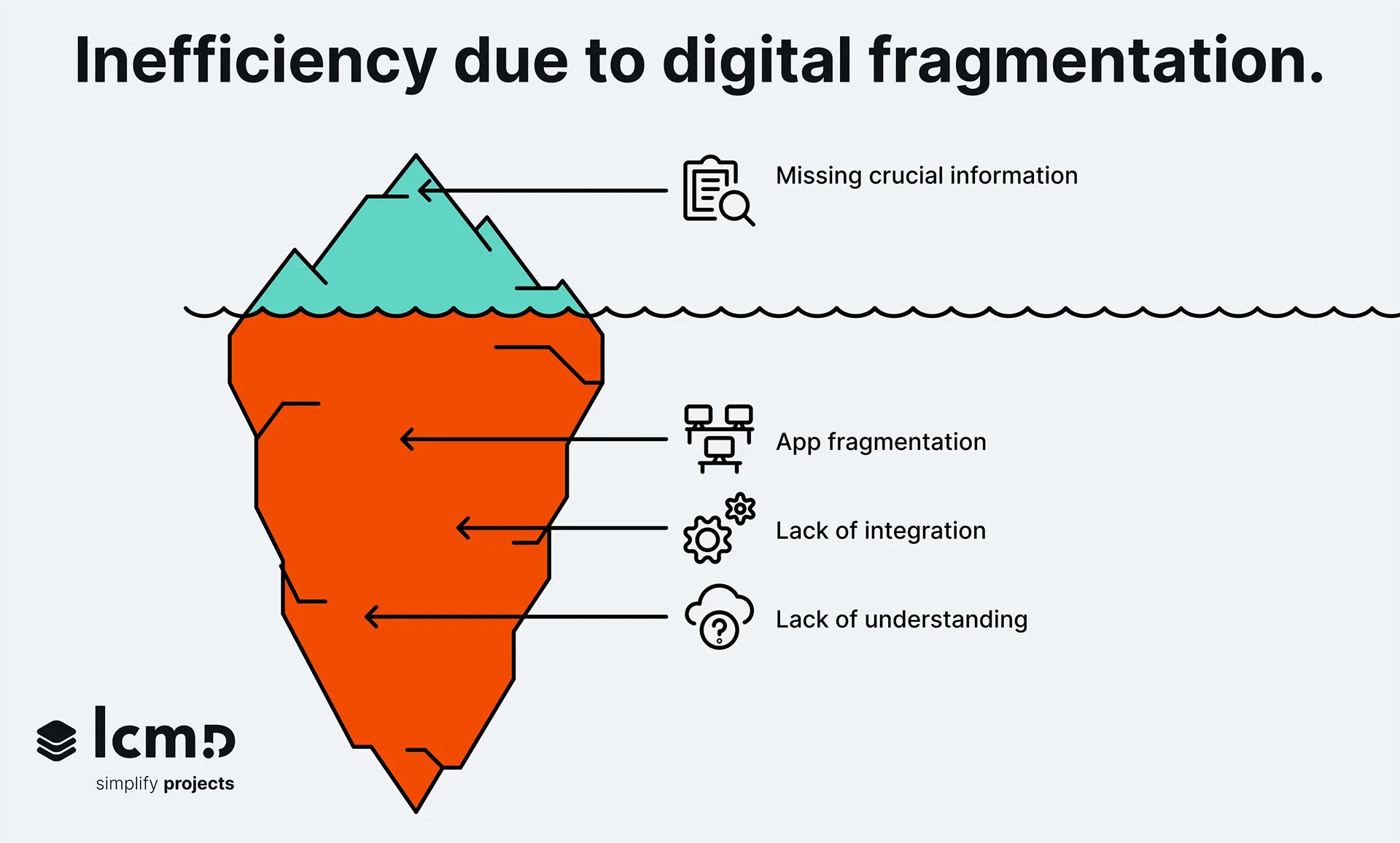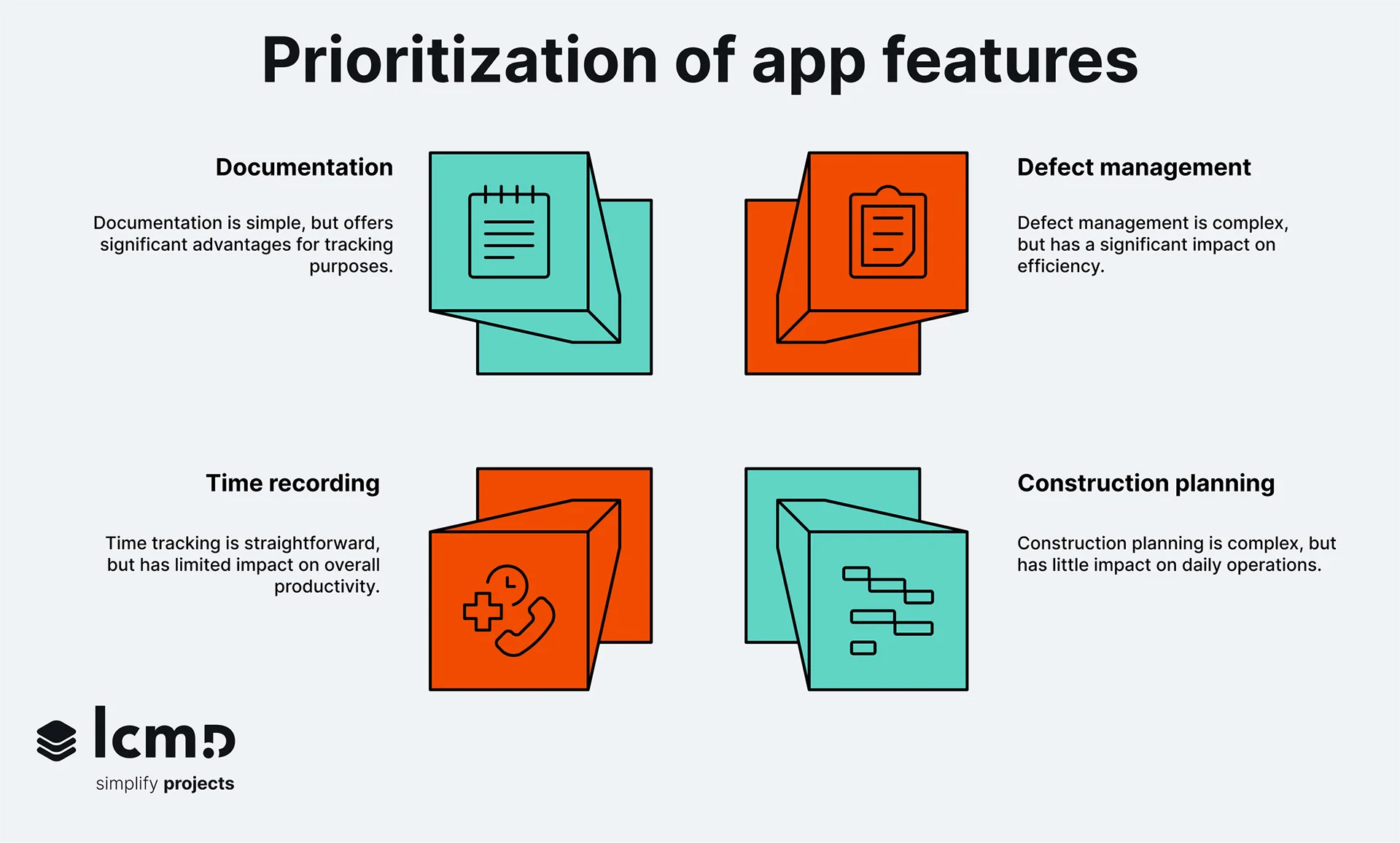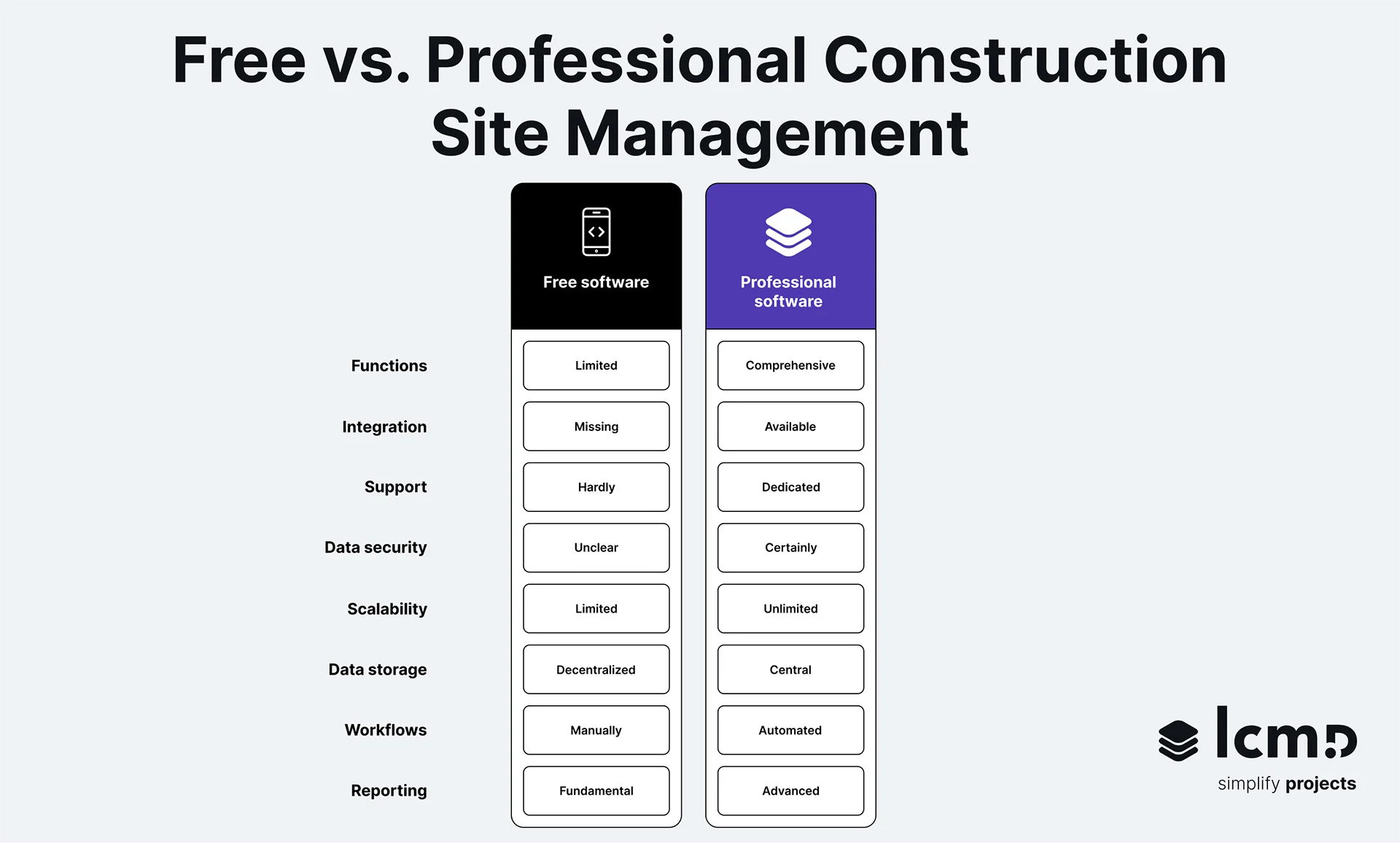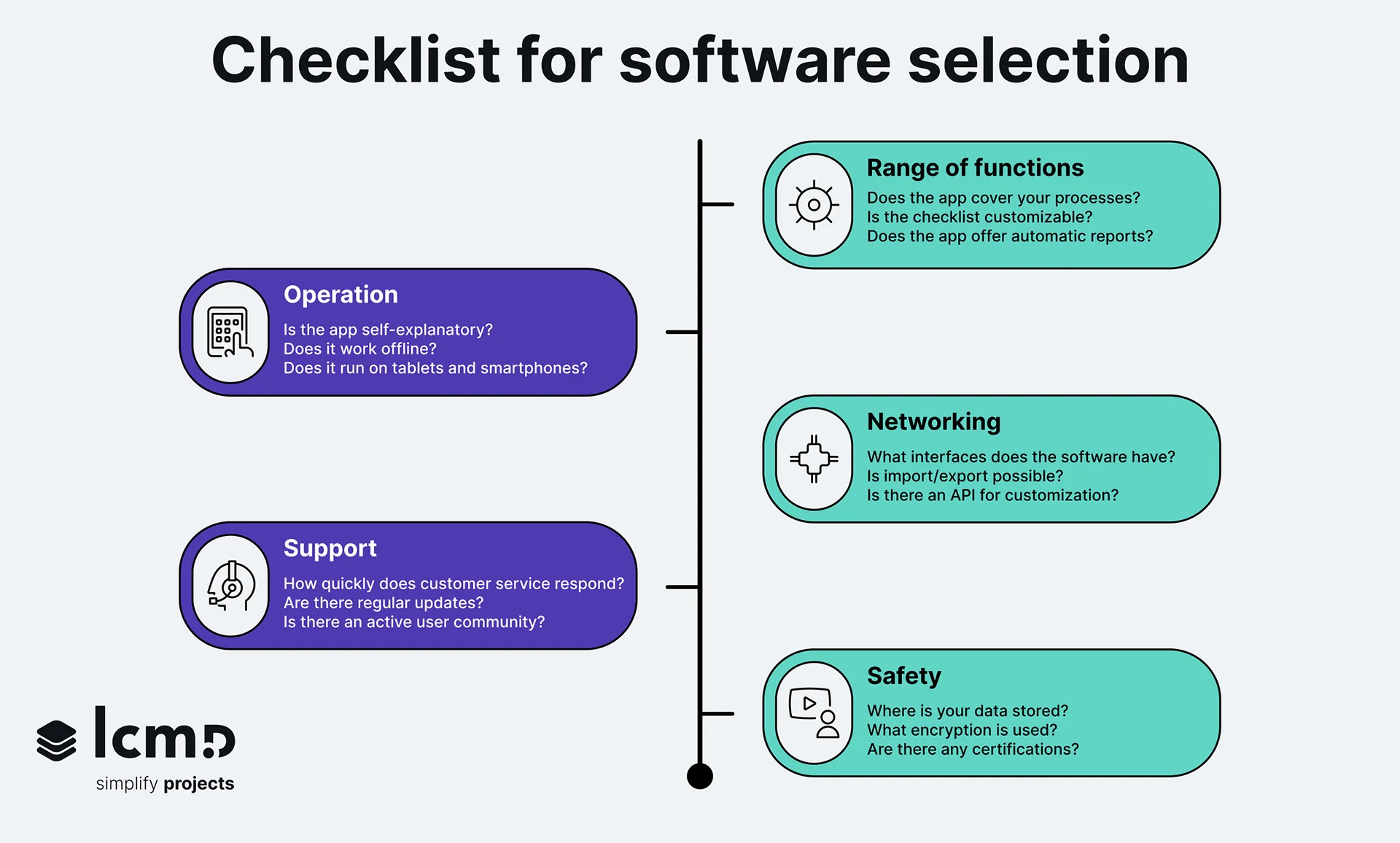Share this article:
Key Takeaways from this article
- The problem: Ten different Construction site apps Without integration, there is more chaos than efficiency — Construction site management software With central data storage, the solution is
core features: A professional Construction manager app Must have construction journal, mobile time recording construction, Defect management app - Offline first: Construction site apps must work without an Internet connection and sync automatically when reconnected
- Think device strategically: Construction site tablet for office containers and plan study, smartphone for quick documentation on site — both devices seamlessly synchronized
- Free vs. professional tools: Free construction diary app sufficient for small projects, if you have several trades and subcontractors, you need Construction management software with automation
- Central data storage eliminates version chaos: Everyone involved works with the same, up-to-date plans and information in real time
- Automated workflows save time: Construction day reports app creates reports automatically Construction management checklistReminds you of repetitive tasks without manual effort
- Integration is key: The best App for construction managers communicates with existing ERP and AVA systems instead of creating additional data silos
Three smartphones, two tablets, one laptop – and you still can't find the information you need. Sounds absurd? It's reality on many construction sites. While the construction industry invests billions in BIM and digitalization, it often fails at the basics: consistent on-site documentation.
The problem isn't a lack of technology. Nearly every team has digital solutions for construction diaries or site management today. The real problem? Ten different construction apps that don't talk to each other. Mobile time tracking construction here, defect management there, communication somewhere else. Each tool works on its own. Together, they create chaos instead of clarity.
This raises the question: Do you really need another app? Or should you understand how professional construction site management software actually works – and what separates it from digital island solutions? The answer determines whether your projects run efficiently or frustratingly.

Digital Tools on the Construction Site - More Than Just a Trend
You know the drill: A folder full of construction diaries, loose notes scattered around, photos on three different phones. The construction industry worked this way for decades. Does it work? Yes. Is it efficient? Not really.
Today, construction companies increasingly rely on digital solutions. Mobile applications for site managers have become standard equipment. But why this shift right now?
The answer lies in three factors: First, projects need real-time information today. Second, more stakeholders work simultaneously on one project. Third, documentation requirements keep rising. Modern construction site apps solve these challenges by giving all participants direct access to current data.
What Professional Construction Site Apps Really Need to Deliver

Core Functions – Not Gimmicks, But Tools
Professional site manager software must prove itself in daily work. Let's look at which functions actually deliver value:
Documentation – The Foundation for Everything
Digital construction documentation is your digital memory. It stores photos with automatic timestamps, assigns notes to the right project, and makes everything searchable. Advanced systems for construction site documentation capture not just what happened, but also when, where, and under what conditions.
The digital construction diary is particularly important. It creates daily reports on weather, personnel, deployed equipment, and special incidents. Sounds like bureaucracy? It is. But when questions come up later – and they will – you have bulletproof documentation.
Time Tracking – Because Hours Are Money
Mobile time tracking construction sounds simple: employees clock in and out via app. But there's more behind it. The system calculates breaks automatically, considers surcharges, and creates reports for payroll.
Free construction site app solutions for time tracking work for small teams with simple structures. Once you work with subcontractors, have different pay grades, or bill by project, you need professional systems.
Defect Management – Before Small Problems Become Big
Here's where it gets interesting: A defect management app doesn't just document defects. It assigns them to the responsible trade, sets deadlines, sends reminders, and logs the resolution. Push notifications ensure nothing gets lost.
The advantage? You don't have to chase down every trade. The system does it for you.
Construction Planning – Looking Ahead
Modern construction planning apps show you more than just schedules. They visualize dependencies between trades, warn about resource conflicts, and help optimize workflows. The construction management software coordinates all participants and ensures everyone knows when they're up.
Tablet or Smartphone – What Makes Sense on the Construction Site?

You're probably right to ask about the right device. A construction site tablet offers a large display – practical when viewing plans or filling out longer forms. The iPad has proven robust and lasts through a workday.
Smartphones have other advantages: They fit in your pocket, are immediately accessible, and sufficient for quick notes or photos. Modern solutions work on both devices and automatically synchronize data in the cloud.
My recommendation? Use both strategically. A tablet for the site office or on-site headquarters – where you study plans or conduct meetings. The smartphone for everything else: quick photos, status updates, team communication.
Free or Professional Solution – A Question of the Project
What Free Apps Can Deliver
Free construction site apps have their place. Simple daily reports can be created with them, photos and notes managed. Basic requirements get covered.
When does this make sense? For smaller projects, when you want to work digitally for the first time, or when your budget is tight. You pay no license fees, can start immediately, and need hardly any training.

However, the limits become visible quickly:
- Functions remain limited
- Integration into existing systems is usually missing
- Support is scarce or nonexistent
- Where your data ends up often remains unclear
- Scaling for larger projects doesn't work
Professional Construction Site Management Software – When It Gets Serious
Professional construction site management is a different league. The construction management software integrates various modules into one system that changes how you work.
Central Data Management – Everyone on the Same Page
Know this problem? The architect works with version 3 of the plan, you have version 4, and the site manager on-site still has version 2. With central construction site software, that's history. Everyone works with the same, current data. Changes synchronize in real-time between office and construction site.
Automated Workflows – Never Forget Routine Tasks Again
The construction management software automates recurring processes. Site inspection every Monday? Once set up, the system automatically creates the checklist. These construction management checklists ensure you don't overlook any points – even when things get stressful.
Reporting – Numbers You Understand
Modern systems for daily construction reports create reports according to your templates. Automatically, daily, without you having to think about it. The software analyzes key figures: Is the project on track? Where are cost overruns emerging? Which trades have delays?
You see problems before they become critical.
Finding the Best App for the Construction Site
Technical Requirements That Really Count
The best solution for your construction site meets certain criteria. Let's go through the most important ones:
Offline Functionality – Because Internet on Construction Sites Is Hit or Miss
Let's be honest: Internet connectivity on construction sites is often miserable. Reinforced concrete, basements, rural areas – the list of dead zones is long. A professional construction site app must work offline. You capture data, and as soon as you have reception again, everything synchronizes automatically.
Intuitive Operation – Because Nobody Has Time for Training
The application must be self-explanatory. Your team has neither time nor patience for two-week training sessions. If someone doesn't understand the software within 10 minutes, they won't use it. It's that simple.
Data Protection – Non-Negotiable
Project data is sensitive. Cost calculations, construction plans, contracts – that doesn't belong in the wrong hands. The construction management software must comply with German and European data protection standards. GDPR compliance is mandatory, not optional.
Integration – Because You Already Have Enough Systems
You already work with ERP software, construction cost estimating programs, or other tools. Your new site manager apps must integrate. Standards like IFC for data exchange should be supported. Otherwise, you're just creating another silo.
Different Approaches for Different Needs
Specialized Documentation Apps
Construction documentation apps focus on one thing: complete capture. Every photo gets metadata – date, time, GPS coordinates, project phase. Notes are stored in structured form, not as a wild collection. These apps do one thing really well.
Plan Management Tools
Digital management of construction plans goes beyond storage. Version control shows which plan is current. Markup functions allow annotations directly in the plan. Distribution to all participants works with one click. No more outdated printouts.
All-in-One Platforms
The comprehensive construction apps in this category combine everything: documentation, time tracking, defect management, communication. This reduces the number of tools and improves overview. However, you also pay for functions you might not need.
What Site Managers Really Need
Daily Work Determines the Requirements
Site managers coordinate everything on the construction site. The specialized apps for site managers must meet this demand:
Keeping Daily Operations Under Control
The construction management app organizes your day: Which trades are working today? Is material missing? Are there problems you need to solve? You see everything at a glance without checking three different lists.
Ensuring Quality
Modern site manager apps document your inspections. You capture defects directly on-site with photos and descriptions. The system automatically assigns them to the responsible trade and tracks resolution. No more Excel lists that nobody updates.
Communication Without Media Breaks
A well-designed construction app enables quick coordination. Question for the architect? Directly from the app. Information to the client? One click. Remind subcontractors? The system does it automatically.
External Site Managers – When Flexibility Matters
An external site manager works differently than permanent employees. You juggle multiple projects simultaneously, switch between clients, and must quickly adapt to new structures. The software must reflect this:
You need quick project setup, clear separation of different mandates, and uncomplicated data exchange with changing project partners. Flexible licensing models help when you don't permanently need all features.
Mobile Time Tracking and Construction Mobile in Practice
What "Construction Mobile" Really Means
The term "construction mobile" describes more than a single app. It's about mobile data capture for all areas:
Material management directly at the ramp: Deliveries are captured upon arrival and immediately assigned to the right trade. No more handwritten delivery notes you have to type up later.
Digital equipment management: Machines and tools are managed in the system. Maintenance intervals run automatically. You get warnings before deadlines expire – not afterward.
Visitor management with system: All people on the construction site are registered. Safety briefings are documented. In case of damage, you know exactly who was on-site when.
Time Tracking That Actually Works
Mobile time tracking construction simplifies payroll significantly. Employees log in and out via the app. The system calculates overtime automatically, considers surcharges, and creates reports for accounting.
Free time tracking construction site app solutions are sufficient for small companies with fewer than ten employees. As soon as you have more complex structures – different pay grades, subcontractors, project-based billing – you need professional software with corresponding analysis capabilities.
From Selection to Daily Use
How to Find the Right Solution
You should approach the decision for construction site management software systematically:
- Clarify requirements: Which processes do you want to map digitally? Which interfaces do you need? Talk to all stakeholders – not just management.
- Survey the market: Compare different applications. Use trial versions intensively. Try real workflows, not just sample data.
- Start small: Deploy the software initially in a manageable project. Gain experience before rolling out the system to all projects.
- Take training seriously: All users must be able to operate the application confidently. Plan time, even for colleagues who "don't have time for this stuff."
- Roll out gradually: Expand usage to additional projects. Learn from each step.
Hurdles in Practical Use
Convince employees, don't steamroll them: Long-time employees often react skeptically to new tools. "We've always done it this way" is a killer argument, but a common one. Show concrete benefits. Give time for familiarization. Listen to feedback.
Ensure data quality from the start: The documentation software is only as good as the data you enter. "Garbage in, garbage out" applies especially here. Define clear standards and regularly check quality.
Integration into existing systems: The construction management software must communicate with your existing IT. Test interfaces thoroughly. Adjust processes where necessary. This takes time but pays off.
Where Things Are Heading – Technology Trends
AI Makes Apps Smarter
Modern construction apps increasingly use artificial intelligence in practical ways: Automatic defect detection in photos. Suggestions for resource allocation based on historical data. Predictive analytics for scheduling. Voice recognition for faster documentation.
Sounds like science fiction? It's partly already reality. Quality continues to rise.
BIM Integration – 3D Instead of Paper
Building Information Modeling is fundamentally changing the construction industry. Integration into modern construction site solutions enables 3D visualization directly on the tablet. Automatic comparison of planned and actual states. Clash detection on-site instead of in the office. Linking building components with their complete documentation.
Anyone choosing BIM-capable software today is investing wisely.
Cloud with Local Backup
The construction site software stores data in the cloud but processes it partially locally. This hybrid approach offers advantages: Performance remains good even when connection is weak. Data security through local encryption. Scalability for large projects. Access from anywhere as soon as internet is available.
Consider Legal Framework
GDPR – Not Just Paperwork
A construction site documentation app processes personal data. This has consequences: You need a transparent privacy policy. Employees must consent to time tracking. Storage and transmission must be secure. Data subjects have rights to information and deletion.
Take this seriously. Violations cost not just money, but also trust.
Audit-Proof Documentation
The software for daily construction reports must meet legal standards: Subsequent changes must remain visible. Timestamps must be tamper-proof. Long-term archiving must work. Audit compliance according to GoBD is mandatory.
This isn't just bureaucracy. In disputes, the quality of your documentation often decides the outcome.
What Does This Really Cost?
Breaking Down the Numbers
The costs of construction management software have two components:
Initial investment: Licenses and setup fees. Hardware like an iPad for construction site or tablet. Training for all users. Customization and integration effort.
Ongoing payments: Monthly or annual license fees. Support and updates. Additional modules as needed. Cloud storage for your data.
Expect 50-150 euros per user per month for professional solutions. Hardware comes extra.
The Benefits in Numbers
Professional construction site management software pays for itself faster than you think:
Time savings: 30-50% less effort for documentation. For a site manager, that's easily 5-10 hours per week. Faster coordination saves additional time. Automatic reports replace hours at the desk.
Fewer errors: Central information reduces misunderstandings. Problems are identified earlier. Everything is transparently documented.
Better quality: Consistent defect management instead of sticky notes. Structured inspections according to plan. Tasks aren't forgotten.
Do the math yourself: What does an hour of site manager time cost you? Multiply by the saved hours. The investment typically pays for itself in 6-12 months.
Practical Tips for Success
Setup That Pays Off
Templates are your friend: Standardized templates for recurring project types save enormous time. The software should be able to maintain project-specific checklists and forms. Once well set up, you use these repeatedly.
Assign permissions wisely: Not everyone needs access to everything. The construction management software should offer role-based permissions. Foremen need different rights than project managers. This protects data and reduces confusion.
Notifications with care: Push notifications for critical events are important. But don't overdo it – otherwise your team ignores all messages. The software should be individually configurable.
Using It Right in Daily Operations
Routine beats resolutions: Schedule fixed times for digital documentation. Documentation "when there's time" doesn't work. Documentation immediately after events works. Best on-site, while everything is still fresh in your mind.
Photos with system: Clear naming conventions are worth their weight in gold. "IMG_1234" helps nobody. "Project_Date_Trade_Description" works better. The app must enable quick retrieval. Use tagging consistently.
Don't forget synchronization: Back up data daily. Sync with the central system. The software should create automatic backups. Don't trust "it'll be fine."
Checklist for Your Decision
When selecting software for site managers, check these points:

Functionality:
- Does the software cover your processes?
- Are construction management checklists customizable?
- Does the system offer automatic daily construction reports?
Operation:
- Is the application self-explanatory?
- Does it work offline?
- Does it run on tablet and smartphone?
Connectivity:
- What interfaces does the construction site software have?
- Is import/export possible?
- Is there an API for custom adjustments?
Support:
- How quickly does customer service respond?
- Are there regular updates?
- Is there an active user community?
Security:
- Where is your data stored?
- What encryption is used?
- Do certifications exist?
Conclusion: The Right Decision Starts with the Right Question
The question is no longer whether you need digital tools for the construction site. The question is: Are you investing in more island solutions or in a system that actually works?
Here's the uncomfortable truth: A free construction site app costs you more than you think – in wasted time, duplicate data maintenance, and missing information at critical moments. Professional construction site management software, on the other hand, doesn't pay for itself someday. It pays for itself from the first project where no information gets lost.
The most successful construction projects in 2025 have one thing in common: They use integrated construction management software that unites various functions – construction documentation, defect management, mobile time tracking construction – in one platform. Not ten different tools, but one solution that grows with your processes.
The trend is clear: BIM integration becomes standard, not optional. AI analyzes your data proactively instead of reactively. Cloud technology makes locations irrelevant. The only question is: When do you get in? When your competitors are already ahead – or now?
Start Today, Not Someday
You want to manage construction plans, automate documentation, and truly coordinate your team? lcmd offers software for site managers that actually works in daily construction site operations. From construction documentation to daily construction reports to complete construction site management software – one platform, one login, all data.
Schedule a demo: Visit www.lcmd.io or talk to our team. We'll show you what construction management software looks like when it's developed for practitioners – not for PowerPoint presentations.



.svg)


.svg)
.svg)





